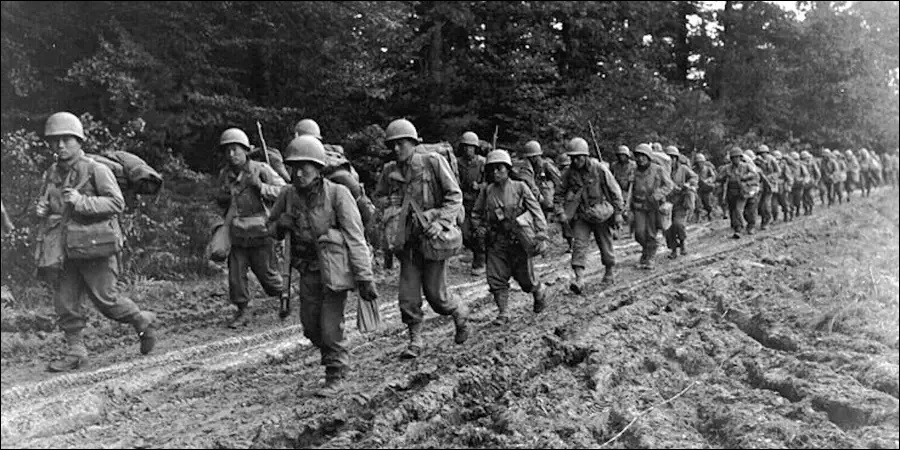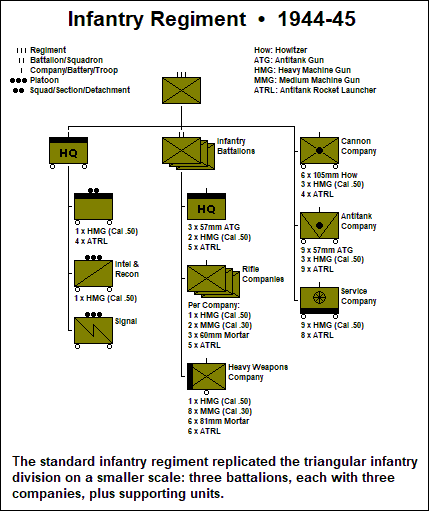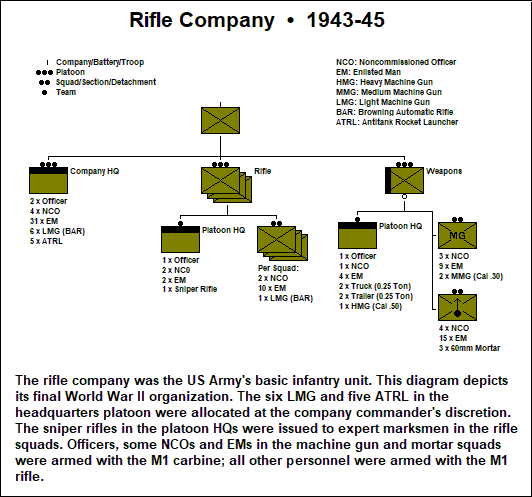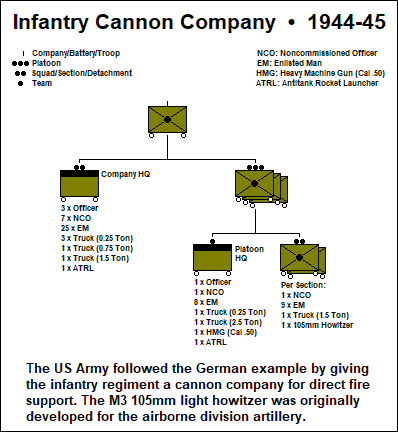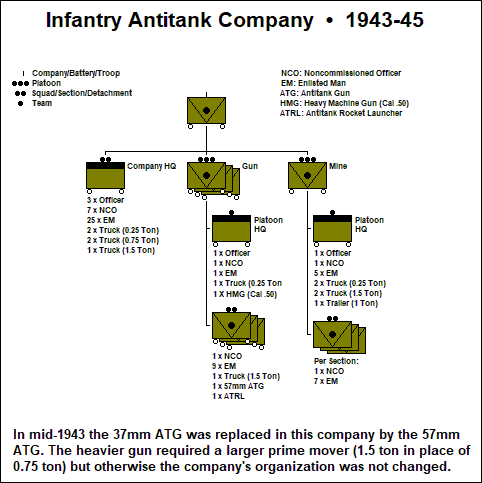|
● ● ●
The US Army’s World War II
infantry division was built around three
infantry regiments. From the Civil War to the Great War the regiment
was the Army’s largest permanent formation, and those of the
Infantry branch were the most numerous. The National Defense Act of
1916 and World War I integrated the National Guard and the National
Army (later the Organized Reserve) with the Regular Army into a
single regimental system with a common regimental organization.
The experience that it acquired on World
War I battlefields greatly influenced the Army’s thinking about the
configuration and tactical employment of the infantry regiment. The
old idea that the individual infantryman, armed with rifle and
bayonet, was the infantry regiment’s primary “weapons system” was
not, indeed, discarded. But trench warfare had revolutionized
small-unit infantry tactics, replacing direct shock action with fire
and maneuver. The German Army had shown the way forward with its
employment of specially trained assault units (Stosstruppen):
infantry battalions incorporating an array of support weapons such
as light machine guns, mortars and flamethrowers. The governing
principle was unity (Einheit): that units at every level
should embody all the resources required to carry out their assigned
tasks.
In the German Army’s 1918 Mob-Division,
each infantry battalion had a
platoon of light trench mortars and a machine gun company in
addition to its four rifle companies. At the regimental level were
found additional support weapons: flamethrowers, heavy trench
mortars, light artillery. When Germany began to rearm in the
mid-1930s, a similar organization was adopted. The
German
infantry regiment
had a cannon company and an antitank gun company, while its
battalions included a heavy company with machine guns and mortars.
The US
Army infantry regiment as reorganized in the 1930s followed the
German Einheit
principle. At the regimental level there was a cannon company and an
antitank gun company. At the battalion level there was a heavy
weapons company with medium mortars and machine guns; the rifle
company included a weapons platoon with light mortars and machine
guns. Thus commanders at every level had available to them an array
of supporting weapons. The commander of a rifle company, for
instance, could support his rifle platoons with the fires of a
machine gun squad and a 60mm mortar squad.
The basic
building block of the rifle platoon, rifle company, infantry
battalion and ultimately the infantry regiment was the rifle squad.
In 1943-45 it consisted of twelve men: two noncommissioned officers
and ten lower enlisted. The squad leader was usually a staff
sergeant; the assistant squad leader could be a sergeant or a
corporal. All personnel except the automatic rifleman were armed
with the M1 semiautomatic rifle. The automatic rifleman was armed
with the M1918A2 Browning Automatic Rifle. Three of the M1 riflemen
also had an M7 rifle grenade launcher. Each platoon had one M1908
Springfield sniper rifle; this was issued to an expert
marksman in one of the squads in place of his M1.
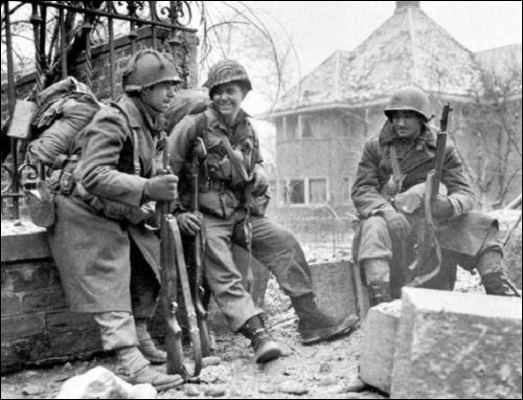
US Army infantrymen, northwest Europe, 1945-45.
(US Army Center of Military History)
Squad
organization for combat was as follows: scout team (squad leader and
two riflemen, one grenade launcher); BAR team (automatic rifleman
and four riflemen); rifle team (assistant squad leader and four
riflemen, two grenade launchers). Tactical doctrine on the attack
was for the scout team to locate the enemy, the BAR team to
establish a base of fire, and the rifle team to maneuver and close
on the objective. Movement when contact was anticipated could also
be be conducted by splitting the squad into two groups, with one
covering the movement of the other in a series of bounds. On
defense, the BAR team was sited to cover the most likely avenue of
approach, with the rest of the squad positioned in support. All of
these formations could be modified as circumstances might dictate.
As things
turned out, however, the rifle squad was rarely employed as an
independent unit. It proved too large to be controlled by the squad
leader when split up into the three teams described above,
especially in view of the chronic shortage of experienced NCOs.
Control, therefore, was exercised at the platoon level and the
squads were not divided up.
Platoon
and company tactics were generally “triangular,” e.g. two
elements up with one held back. When attacking, the third
element would be the maneuver force, moving to a flank and
conducting a close assault while the other two elements provided fire support. On defense it was
customary for two elements to man the line with the third one in
reserve, positioned to mount a counterattack in case of a breakthrough.
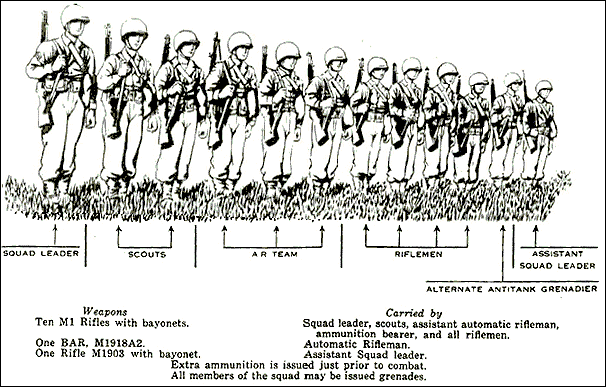
Organization of the infantry rifle squad as
depicted in a WW II Army field manual (War Department publication)
At the
regimental level, the cannon and antitank companies proved somewhat
disappointing. Originally (1942) the former was equipped with 6 x
75mm guns and 2 x 105mm howitzers mounted on armored halftracks. But
these self-propelled assault guns were soon replaced by 6 x towed
M3 105mm light howitzers, a weapon originally developed for the
airborne divisions. This change was in line with the desire to keep the
infantry division as light as possible. Unfortunately the towed howitzers were
insufficiently mobile and too vulnerable to be employed in close
support of the infantry. Nor did the cannon company possess the fire direction
capabilities necessary to deliver accurate indirect fire. Thus it
was usually attached to the division artillery. The antitank
company's towed M1 57mm antitank guns also lacked mobility, and at
best they were marginally effective against the
German tanks encountered in 1943-45. These deficiencies were noted
in a review of the infantry division conducted by the General Board,
European Theater of Operations, US Army, immediately after the
termination of hostilities in June 1945.
The General
Board's conclusions had been anticipated in the second half of the
war when it became common practice to employ the infantry regiment
in the form of a regimental combat team (RCT). The RCT was created
by attaching various units to the infantry regiment, typically a
105mm field artillery battalion, a combat engineer company, a tank
company or tank destroyer company, etc. The RCT thus bore a certain
similarity to the German Army's Kampfgruppe (battle group)
concept, i.e. task organization for combat. Some of the
units used to augment the regiment were organic to the infantry
division but others, particularly the tanks and tank destroyers,
were not. The Board recommended that the future infantry division
should include an organic tank battalion whose companies could be
allotted to the regiments, and this recommendation was adopted in
the postwar period.
● ● ●
|
